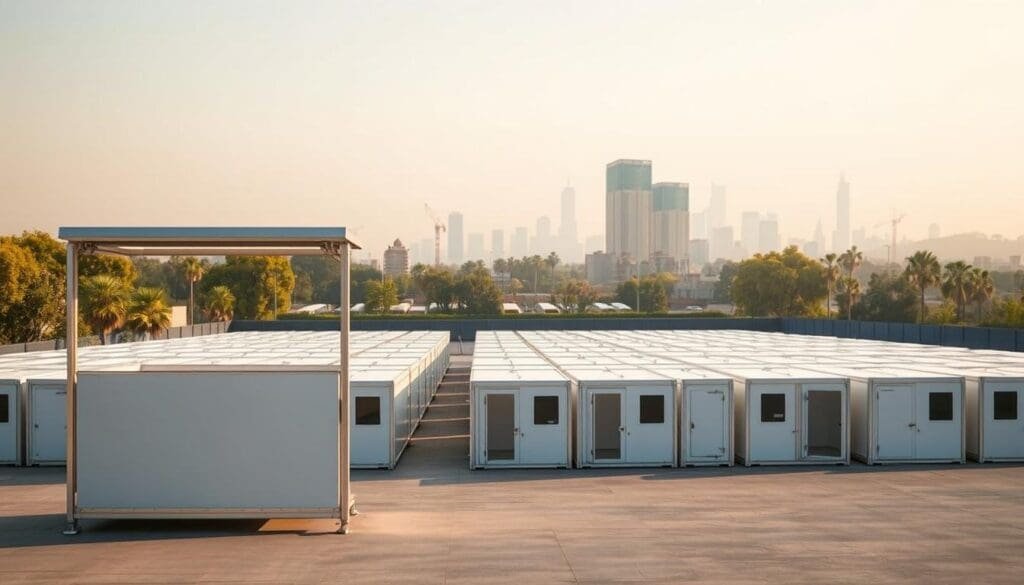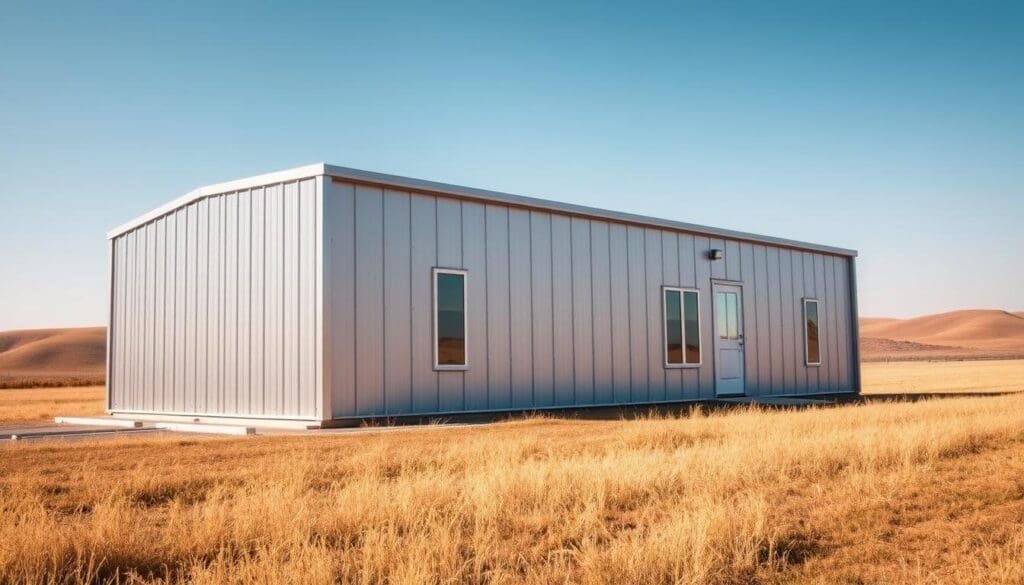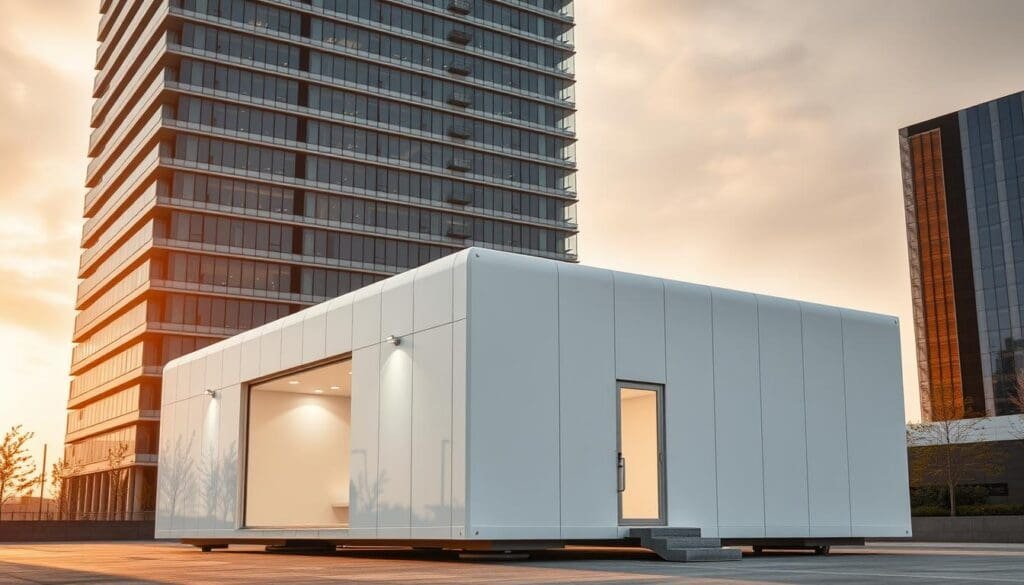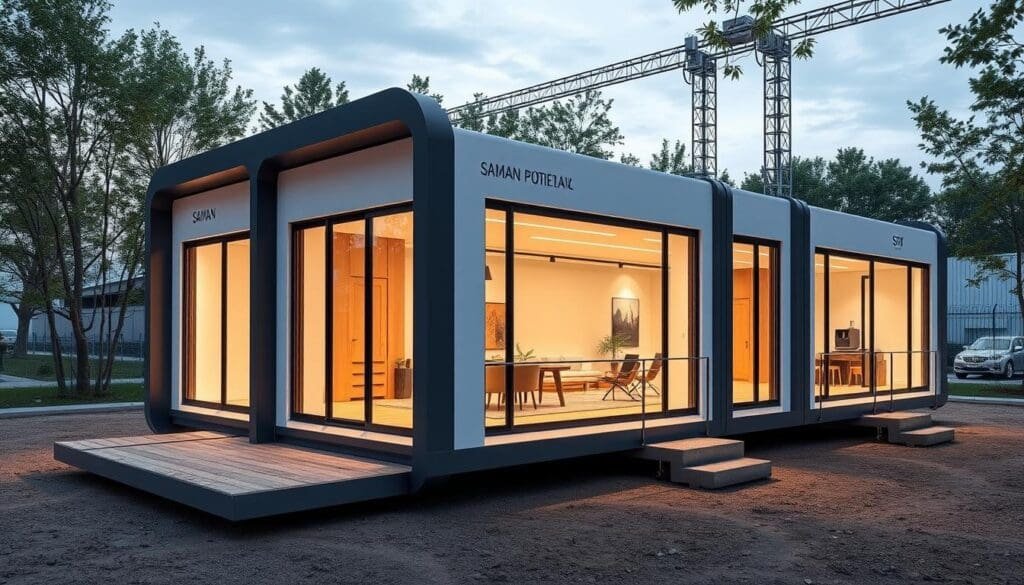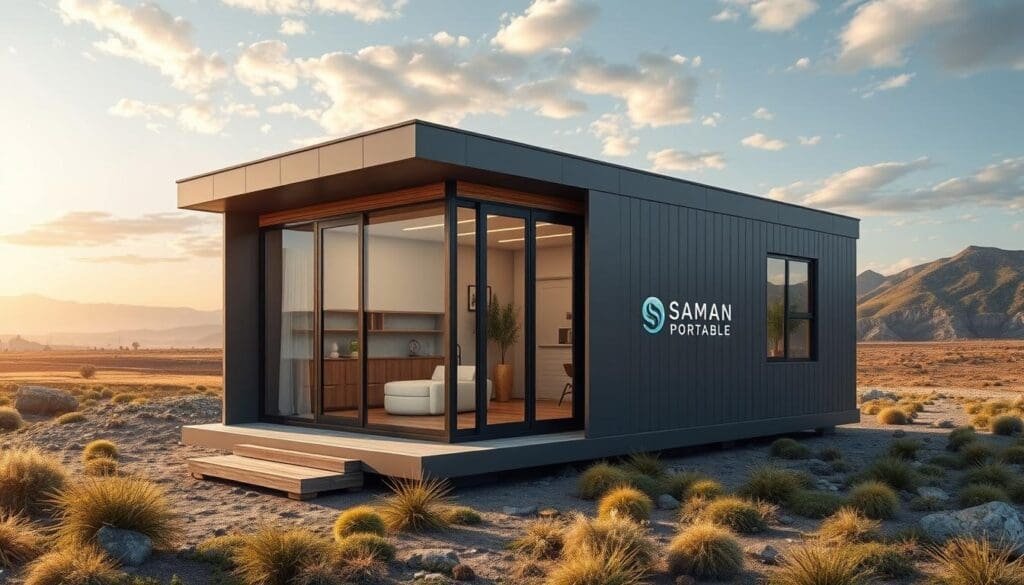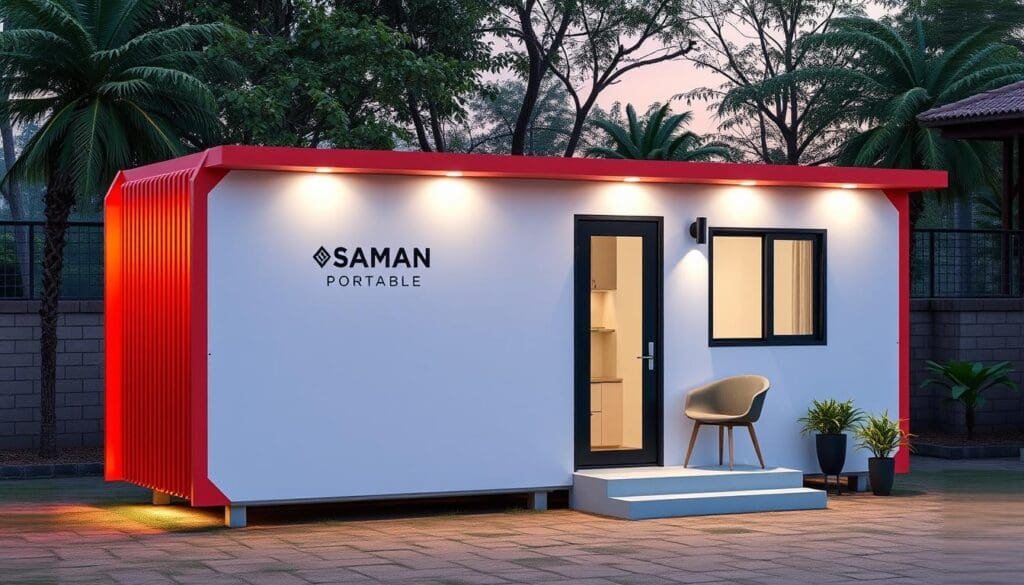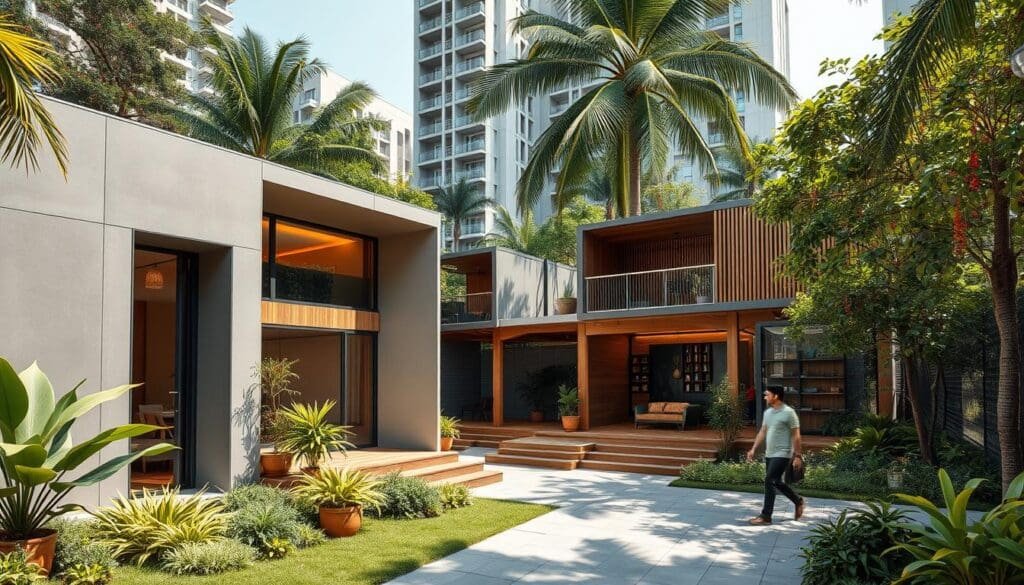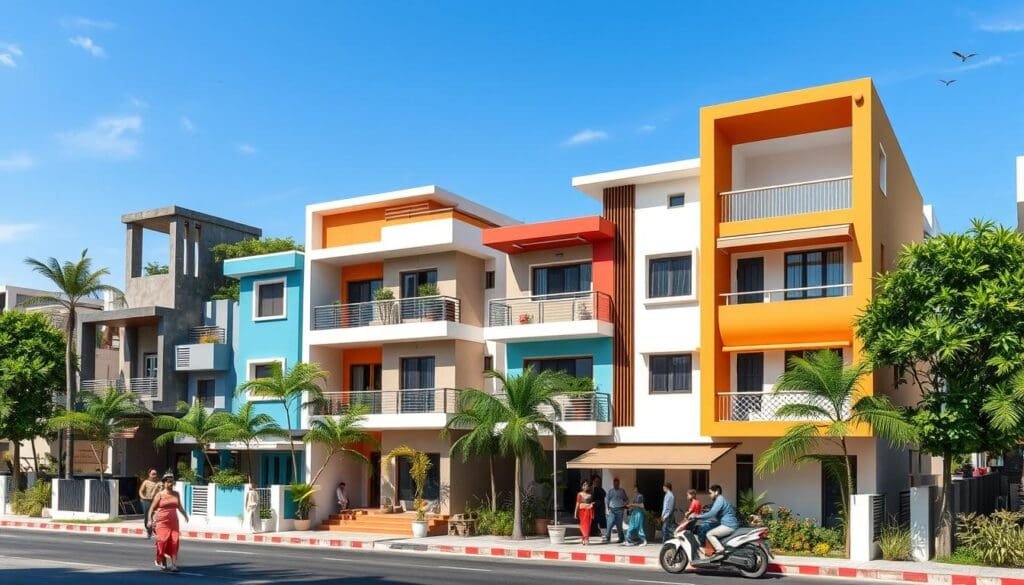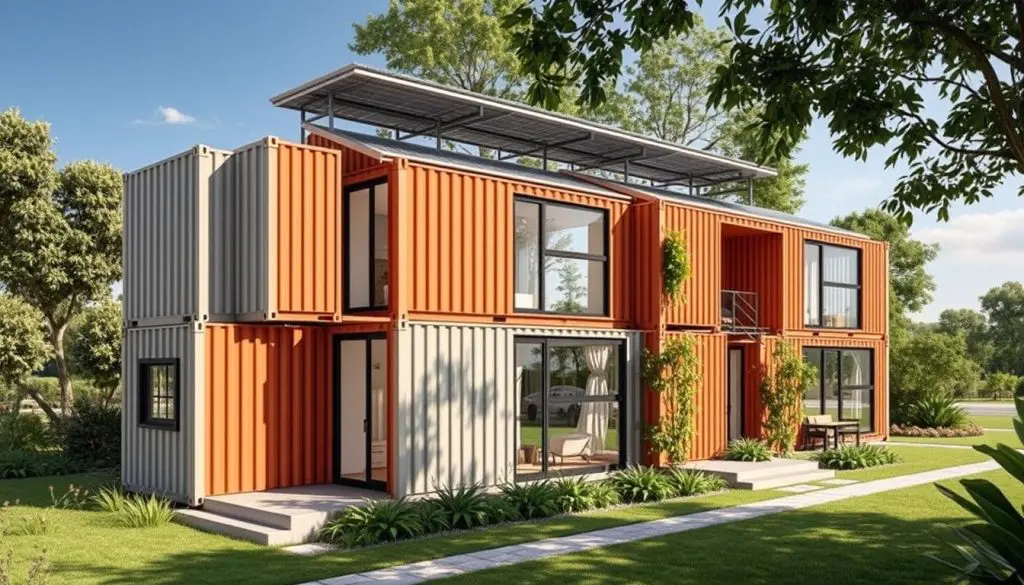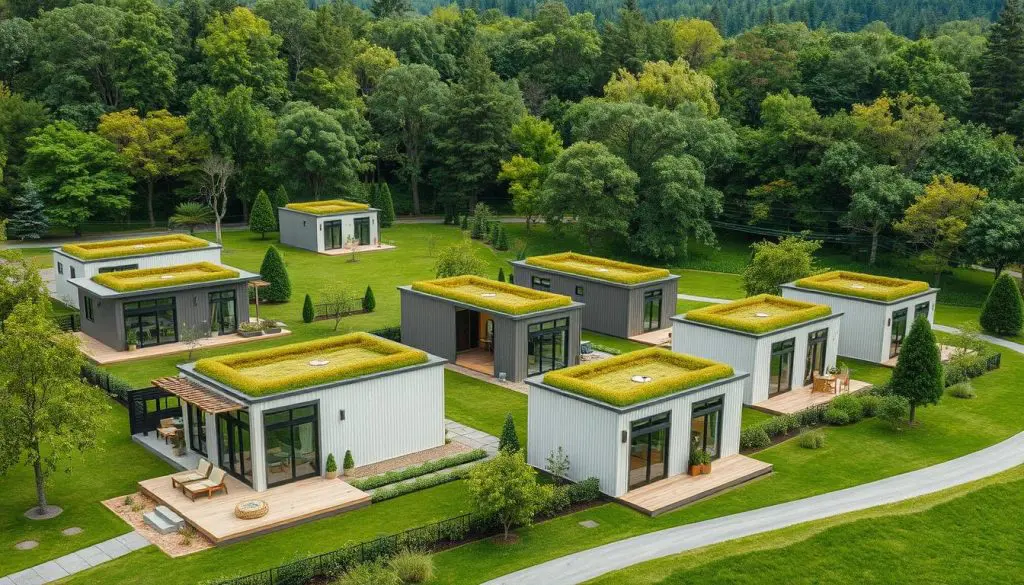10 Essential Features of Modern Labor Accommodations for 2024
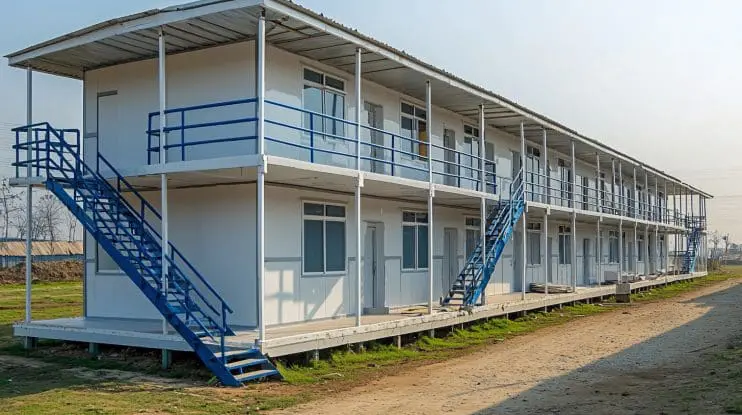
Introduction to Modern Labor Accommodations in Bangalore
Labor accommodations are essential for workers on remote or large-scale projects. These facilities provide housing and basic services for laborers. With growing demand, modern labor accommodations must meet specific needs. In 2024, there are new features that make these facilities more comfortable and efficient. Understanding these features helps you make informed decisions. You can ensure that your workers are well taken care of, leading to better productivity.
Today, labor accommodations are not just about providing a roof over workers’ heads. They must offer safety, comfort, and efficiency. These features contribute to worker satisfaction and retention. A good accommodation setup can reduce turnover and increase job satisfaction. This is why it’s important to choose the right features for your labor colonies. This guide will cover 10 essential features that you should consider in 2024.
Knowing what to include in your labor accommodations is crucial. It helps in budgeting and planning. It also ensures that you comply with legal standards. Additionally, workers are more likely to stay if their needs are met. The goal of this guide is to help you choose the best features for your labor accommodations. This will lead to a better work environment and higher productivity. Explore our quality prefab labor colonies for modern workforce housing solutions.
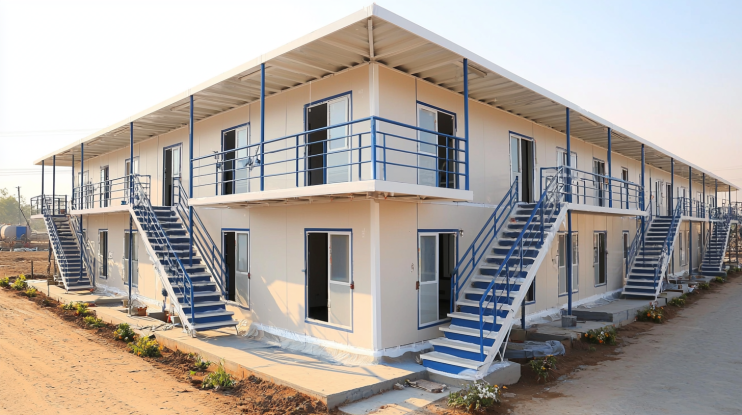
Two-storey prefab labor colony with white GI frames, blue handrails, and 16 rooms near a dam.
1. Sustainability in Labor Accommodations
Sustainability is a key feature of modern labor accommodations. Using eco-friendly materials helps reduce the environmental impact. For instance, solar panels can be used for energy needs. This reduces electricity costs and the carbon footprint. Additionally, proper waste management systems are essential. These systems ensure that waste is disposed of in an environmentally friendly way. Sustainability not only benefits the environment but also attracts eco-conscious companies.
Incorporating sustainable practices into labor accommodations is becoming increasingly important. Companies are now more aware of their environmental responsibilities. Workers also appreciate accommodations that align with green practices. Sustainable accommodations are not only good for the environment but also reduce long-term operational costs. This makes them a smart choice for any company looking to invest in labor accommodations.
Implementing sustainable features in labor accommodations requires planning. However, the benefits are worth the effort. Companies can reduce their environmental impact and save on operational costs. Workers benefit from living in an environment that is healthier and more comfortable. Overall, sustainability is a win-win for both companies and workers. This is why it should be a top consideration when planning labor accommodations. See how sustainable practices are implemented in our projects.
2. Modular Design for Flexibility
Modular design is another essential feature of modern labor accommodations. Modular buildings are constructed in sections, or modules, off-site. These modules are then transported to the location and assembled. This approach offers flexibility and speed. Modular accommodations can be expanded or reduced based on the needs of the project. This makes them ideal for large-scale or changing projects.
Flexibility is crucial in labor accommodations. As project needs change, so do the requirements for housing. Modular accommodations allow companies to adjust quickly. If more workers are hired, additional modules can be added. If the workforce is reduced, modules can be removed or repurposed. This adaptability makes modular design a valuable feature for labor accommodations.
In addition to flexibility, modular design also offers cost savings. Since modules are built off-site, construction is faster and less expensive. This reduces the overall cost of labor accommodations. Moreover, modular accommodations can be reused for different projects. This makes them a cost-effective solution in the long run. Companies should consider modular design when planning labor accommodations.
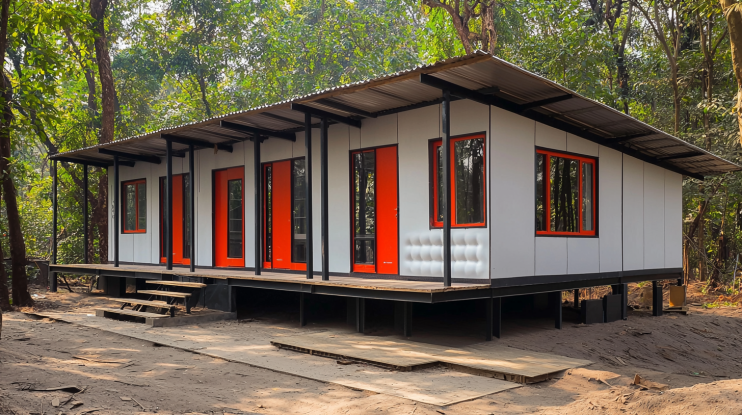
Single-storey prefab labor colony with black GI frames, red windows, and 10 rooms in a forested area.
3. Enhanced Safety and Security
Safety is a top priority in labor accommodations. Workers need to feel safe and secure in their living spaces. Modern labor accommodations are equipped with advanced security systems. These include surveillance cameras, secure access control, and emergency alarms. Additionally, fire safety systems are essential. Fire alarms, extinguishers, and emergency exits should be installed. These features ensure the safety of workers and compliance with safety regulations.
Security is not just about technology. It also involves proper planning and design. Labor accommodations should be well-lit and have clear pathways. This reduces the risk of accidents and improves overall security. Regular safety drills are also important. Workers should know what to do in case of an emergency. This prepares them to act quickly and safely when needed.
Investing in safety and security features is crucial. It protects workers and reduces the risk of accidents or incidents. This, in turn, reduces liability for the company. Safe labor accommodations also lead to higher worker satisfaction. Workers are more likely to stay if they feel safe in their environment. Therefore, safety and security should be a top consideration when planning labor accommodations.
4. Comfort and Livability
Comfort is an essential feature of labor accommodations. Workers spend a significant amount of time in these facilities. Therefore, the living conditions should be comfortable. Modern labor accommodations include features like air conditioning, heating, and proper ventilation. These features ensure that the living environment is pleasant, regardless of the weather conditions. Comfortable accommodations lead to happier and more productive workers.
Livability is more than just comfort. It also involves the availability of basic amenities. Workers should have access to clean water, sanitation facilities, and cooking areas. Additionally, recreational facilities are important. These can include gyms, common rooms, and outdoor spaces. Providing these amenities improves the quality of life for workers. It also contributes to higher job satisfaction and lower turnover rates.
Investing in comfort and livability is beneficial for both workers and companies. Comfortable workers are more productive and less likely to leave. This reduces recruitment and training costs. Additionally, high-quality accommodations can be a selling point for attracting skilled workers. Therefore, comfort and livability should be a priority when planning labor accommodations.
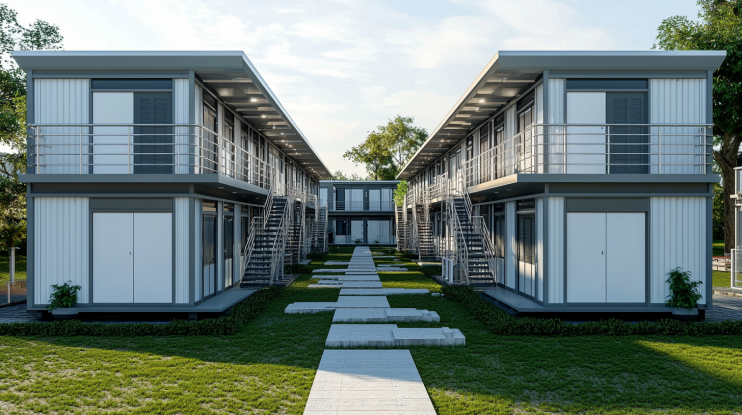
riple-storey prefab labor colony with grey GI frames, white doors, and 20 rooms in an urban area.
5. Accessibility and Inclusivity
Accessibility is a critical feature of modern labor accommodations. Workers with disabilities should be able to access all areas of the accommodation. This includes ramps, wide doorways, and accessible bathrooms. Providing these features ensures that all workers can live comfortably. Inclusivity is not just about physical accessibility. It also involves creating a welcoming environment for workers from diverse backgrounds.
Inclusivity goes beyond physical features. It also involves cultural sensitivity. Workers from different cultural backgrounds may have different needs. For example, some workers may require separate cooking areas or prayer rooms. Providing these facilities shows respect for their cultural practices. This contributes to a positive work environment and helps retain workers.
Ensuring accessibility and inclusivity in labor accommodations requires careful planning. It involves understanding the needs of your workforce and designing accommodations that meet those needs. This not only benefits workers but also improves the overall efficiency of the workforce. An inclusive environment is a productive environment. Therefore, accessibility and inclusivity should be a top priority in labor accommodations. how we design labor colonies to be inclusive and accessible.
6. Technological Integration
Technology plays a significant role in modern labor accommodations. Smart technology can be integrated into accommodations to improve efficiency and comfort. For example, automated lighting and climate control systems can be installed. These systems adjust to the needs of the occupants, reducing energy consumption. Additionally, technology can improve security. Surveillance cameras and access control systems can be monitored remotely.
The use of technology in labor accommodations is not just about convenience. It also improves safety and efficiency. Automated systems reduce the need for manual intervention. This lowers the risk of errors and accidents. Additionally, technology can be used to monitor the health and well-being of workers. For example, wearable devices can track vital signs and alert management if there are any concerns.
Integrating technology into labor accommodations requires investment. However, the benefits far outweigh the costs. Technology improves the living conditions for workers and reduces operational costs. It also enhances safety and security. Therefore, technological integration should be considered when planning labor accommodations.
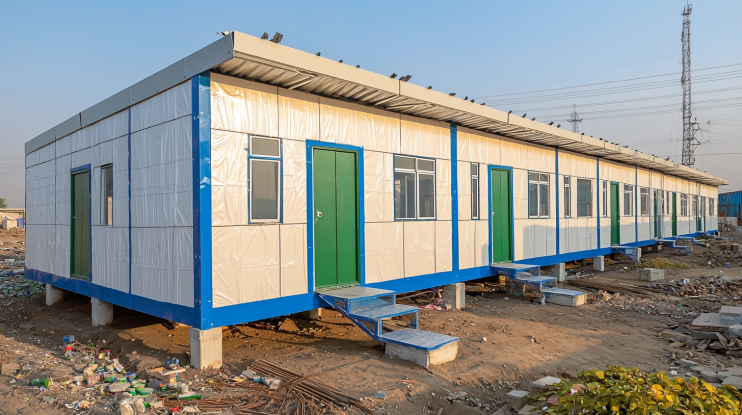
Single-storey prefab labor colony with blue GI frames, green doors, and 16 rooms at a construction site.
7. Recreational Facilities and Amenities
Recreational facilities are an important feature of labor accommodations. Workers need a place to relax and unwind after a long day. Providing recreational facilities, such as gyms, common rooms, and outdoor spaces, improves the quality of life for workers. These facilities allow workers to stay active and socialize. This, in turn, leads to higher job satisfaction and better mental health.
Amenities are not just about recreation. They also include essential services, such as laundry facilities, canteens, and medical care. Providing these amenities ensures that workers have access to everything they need. This reduces the need for workers to leave the accommodation, improving safety and security. Additionally, providing amenities reduces stress and improves the overall well-being of workers.
Investing in recreational facilities and amenities is beneficial for both workers and companies. Happy, healthy workers are more productive and less likely to leave. This reduces turnover and recruitment costs. Additionally, high-quality accommodations can be a selling point for attracting skilled workers. Therefore, recreational facilities and amenities should be a priority in labor accommodations.
8. Efficient Use of Space
Efficient use of space is crucial in labor accommodations. Space is often limited, so it’s important to make the most of what is available. This involves smart design and layout. For example, multi-functional furniture can save space. Bunk beds, foldable tables, and storage units can be used to maximize the available space. This ensures that workers have enough room to live comfortably.
In addition to smart design, efficient use of space also involves proper planning. It’s important to consider the needs of the workers when designing the layout. For example, living areas should be separate from working areas to reduce noise and distractions. This improves the quality of life for workers and increases productivity. Efficient use of space also reduces costs by minimizing the need for additional accommodations.
Investing in efficient use of space is beneficial for both workers and companies. It improves the living conditions for workers and reduces operational costs. Additionally, efficient use of space can be a selling point for attracting skilled workers. Therefore, efficient use of space should be a priority when planning labor accommodations.
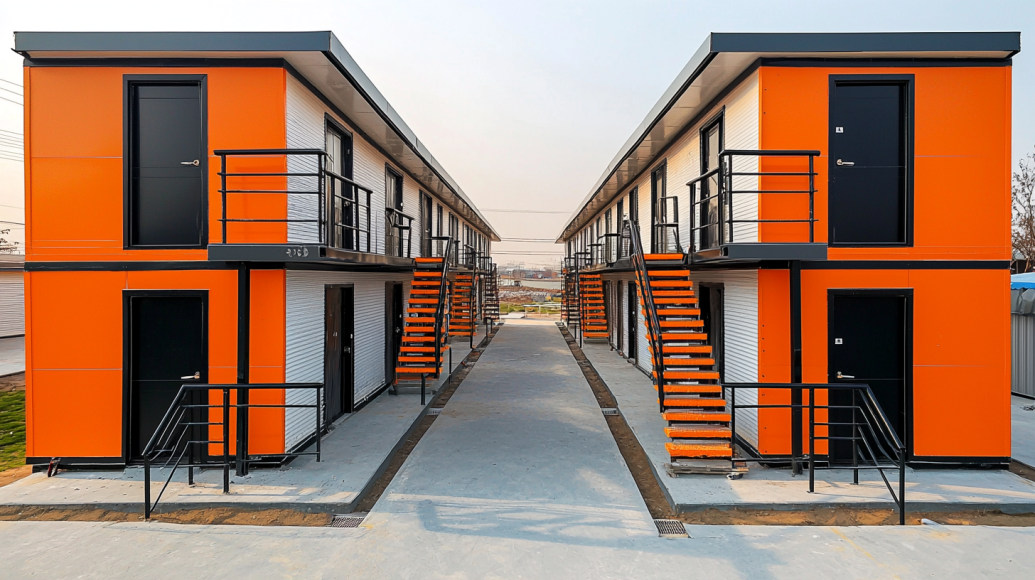
Two-storey prefab labor colony with orange GI frames, black doors, and 20 rooms in a mining area.
9. Hygiene and Sanitation Standards
Hygiene and sanitation are critical in labor accommodations. Proper sanitation facilities are essential for the health and well-being of workers. This includes clean bathrooms, showers, and waste disposal systems. Regular cleaning and maintenance are also important to prevent the spread of disease. Providing proper hygiene facilities shows that you care about the health of your workers.
In addition to sanitation, hygiene also involves personal cleanliness. Workers should have access to laundry facilities and clean water. This ensures that they can maintain personal hygiene. Providing these facilities improves the overall well-being of workers and reduces the risk of illness. It also contributes to a positive work environment.
Investing in hygiene and sanitation standards is crucial for the health and safety of workers. It reduces the risk of disease and improves the quality of life for workers. This, in turn, leads to higher productivity and lower turnover rates. Therefore, hygiene and sanitation should be a top priority in labor accommodations. Discover our commitment to high hygiene standards in labor accommodations.
10. Cost-Effectiveness in Labor Accommodations
Cost-effectiveness is a crucial consideration when planning labor accommodations. Companies must balance quality with budget constraints. Cost-effective accommodations do not mean compromising on quality. Instead, it involves smart choices in materials, design, and construction methods. For example, using modular designs can reduce construction costs while maintaining high standards.
Investing in cost-effective labor accommodations can result in significant long-term savings. Efficient energy systems, durable materials, and smart designs reduce maintenance costs over time. Moreover, comfortable and well-equipped accommodations can reduce worker turnover, saving on recruitment and training expenses. Therefore, cost-effectiveness should be a key consideration in labor accommodation planning.
Careful planning and budgeting are essential for cost-effective labor accommodations. It’s important to assess all potential expenses, including construction, maintenance, and operational costs. By making informed decisions, companies can provide high-quality accommodations while staying within budget. This approach ensures that the accommodations meet the needs of the workers without unnecessary expenditures.
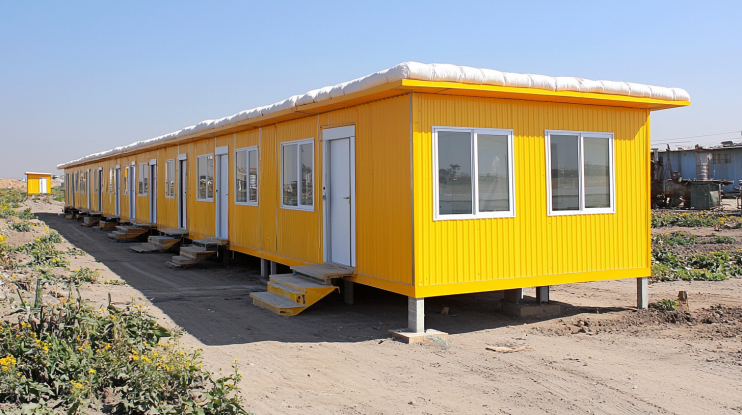
L-shaped single-storey prefab labor colony with yellow GI frames in a remote oil field.
Remote Location Solutions for Labor Accommodations
Providing labor accommodations in remote locations presents unique challenges. These areas often lack infrastructure, making it difficult to provide essential services. However, modern solutions are available to address these challenges. Portable and modular accommodations are ideal for remote locations. They can be easily transported and set up on-site, reducing the need for extensive infrastructure.
In addition to portability, remote labor accommodations must be self-sufficient. This includes providing reliable sources of power, water, and waste management. Solar panels, water purification systems, and waste recycling facilities are essential. These features ensure that workers have access to the necessary amenities, even in remote areas.
Investing in self-sufficient labor accommodations for remote locations is crucial. It ensures that workers have a safe and comfortable living environment, regardless of the location. Additionally, self-sufficient accommodations reduce the reliance on external resources, reducing operational costs. This makes them a smart choice for companies working in remote areas.
Legal and Regulatory Compliance in Labor Accommodations
Legal and regulatory compliance is essential in labor accommodations. Companies must adhere to local, national, and international standards. This includes health and safety regulations, building codes, and labor laws. Compliance ensures that the accommodations meet the required standards for worker safety and comfort. It also reduces the risk of legal issues and penalties.
Understanding and adhering to legal requirements can be complex. Regulations vary by location and may change over time. Therefore, it’s important to stay informed about relevant laws and standards. Working with legal experts or consultants can help ensure compliance. This proactive approach prevents potential legal issues and ensures that the accommodations meet all necessary standards.
Investing in legal and regulatory compliance is crucial for protecting workers and the company. Non-compliance can result in fines, legal action, and damage to the company’s reputation. By ensuring that labor accommodations meet all regulatory requirements, companies can provide a safe and legal living environment for their workers.
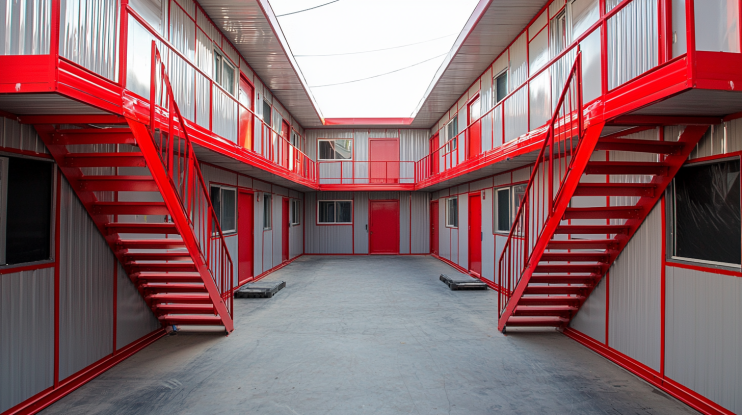
Triple-storey prefab labor colony with red GI frames and 20 rooms at a large infrastructure project.
Cultural Sensitivity and Social Considerations
Cultural sensitivity is an important aspect of labor accommodations. Workers from different cultural backgrounds may have specific needs and preferences. Providing accommodations that respect these needs is crucial for maintaining a positive work environment. This includes considerations such as food preferences, religious practices, and social customs.
In addition to cultural sensitivity, social considerations are also important. Labor accommodations should promote a sense of community among workers. This can be achieved by providing communal spaces, such as dining halls and recreation areas. These spaces allow workers to interact and build relationships, improving morale and job satisfaction.
Investing in cultural sensitivity and social considerations benefits both workers and the company. Workers who feel respected and valued are more likely to be satisfied with their living conditions. This, in turn, leads to higher productivity and lower turnover rates. Therefore, cultural sensitivity and social considerations should be a priority in labor accommodations.
Health and Wellness Facilities
Health and wellness facilities are essential in labor accommodations. Workers should have access to basic health services, such as medical check-ups and emergency care. Additionally, wellness programs can promote healthy lifestyles among workers. This includes fitness facilities, mental health support, and nutritional guidance. Providing these services ensures that workers stay healthy and productive.
Investing in health and wellness facilities is beneficial for both workers and companies. Healthy workers are more productive and less likely to take sick leave. This reduces the cost of absenteeism and improves overall efficiency. Additionally, providing health and wellness services can be a key factor in attracting and retaining skilled workers.
Planning for health and wellness facilities in labor accommodations requires careful consideration. It’s important to assess the specific needs of the workforce and provide appropriate services. This ensures that the facilities are used effectively and meet the needs of the workers. By prioritizing health and wellness, companies can create a supportive and productive work environment.
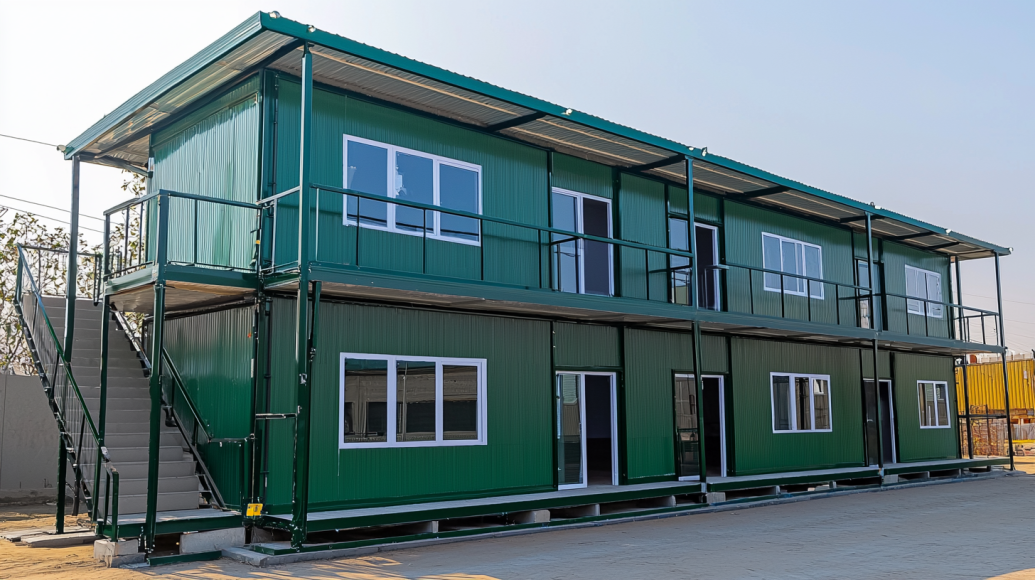
Double-storey prefab labor colony with green GI frames and 16 rooms at an industrial site
Energy Efficiency in Labor Accommodations
Energy efficiency is an important feature of modern labor accommodations. Reducing energy consumption not only lowers costs but also minimizes environmental impact. This can be achieved through the use of energy-efficient systems, such as LED lighting, solar panels, and advanced HVAC systems. These systems reduce the amount of energy required to maintain comfortable living conditions.
In addition to reducing energy consumption, energy-efficient systems also offer long-term savings. Although the initial investment may be higher, the reduction in energy costs over time can result in significant savings. Furthermore, energy-efficient accommodations are more attractive to environmentally conscious companies and workers.
Investing in energy efficiency is a smart choice for labor accommodations. It reduces operational costs and supports sustainability goals. Additionally, energy-efficient accommodations contribute to a healthier living environment for workers. This improves overall job satisfaction and productivity. Therefore, energy efficiency should be a top priority in the design and construction of labor accommodations.
Privacy and Personal Space in Labor Accommodations
Privacy is an important aspect of labor accommodations. Workers need personal space where they can relax and unwind. This can be challenging in communal living environments. However, modern labor accommodations are designed with privacy in mind. Features such as individual rooms, partitions, and soundproofing help create private spaces for workers.
Providing personal space is not just about physical separation. It also involves respecting workers’ need for quiet time and personal activities. This includes providing private areas for reading, studying, or meditation. By respecting workers’ need for privacy, companies can create a more comfortable and supportive living environment.
Investing in privacy and personal space is crucial for worker well-being. It reduces stress and improves mental health, leading to higher productivity. Additionally, workers who have access to private spaces are more likely to stay with the company. Therefore, privacy and personal space should be a priority in labor accommodations.
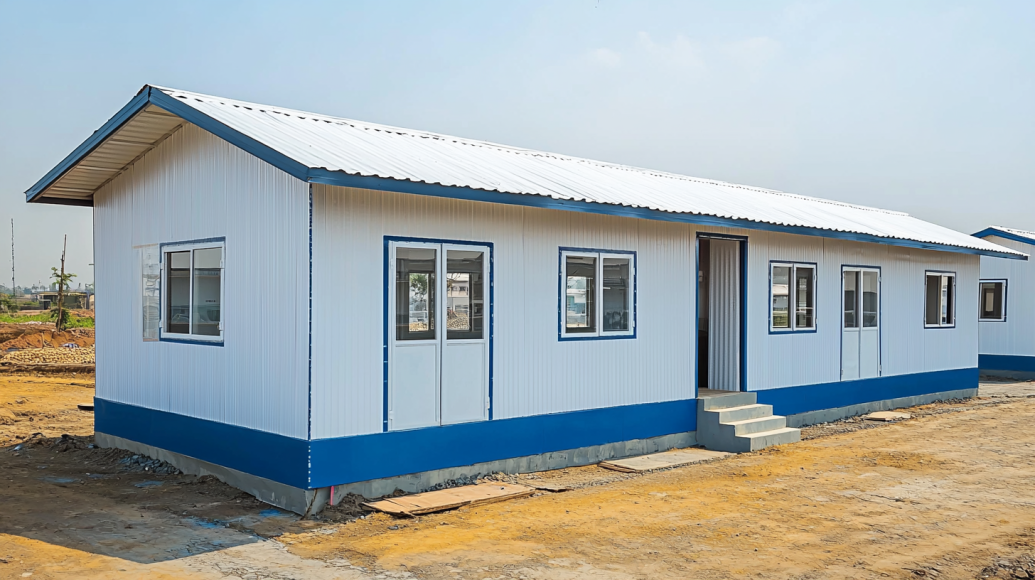
Single-storey prefab labor colony with blue GI frame and 10 rooms on a rural construction site.
Emergency Preparedness in Labor Accommodations
Emergency preparedness is essential in labor accommodations. Workers need to know what to do in case of an emergency, such as a fire, natural disaster, or medical crisis. Modern labor accommodations are equipped with emergency systems, such as fire alarms, evacuation routes, and first aid kits. Regular drills are also conducted to ensure that workers are prepared.
Investing in emergency preparedness reduces the risk of accidents and saves lives. It also minimizes damage to property and reduces the company’s liability. Furthermore, workers who feel safe are more likely to be satisfied with their living conditions. This improves morale and productivity.
Planning for emergency preparedness requires careful consideration. It involves identifying potential risks and implementing appropriate measures. This includes providing training and conducting regular drills. By prioritizing emergency preparedness, companies can ensure the safety and well-being of their workers in labor accommodations.
Adaptability to Climate and Environment
Adaptability to climate and environmental conditions is crucial in labor accommodations. Workers may be located in areas with extreme weather conditions, such as high temperatures, heavy rainfall, or strong winds. Modern labor accommodations are designed to withstand these conditions. This includes features such as insulation, weatherproofing, and climate control systems.
Investing in climate-adaptable accommodations ensures that workers remain comfortable and safe. It also reduces the risk of damage to the accommodations. This is particularly important in remote or harsh environments, where repairs may be difficult and costly. Adaptable accommodations also improve the overall quality of life for workers.
Planning for climate adaptability requires understanding the specific environmental conditions of the location. This involves selecting appropriate materials and systems that can withstand the local climate. By investing in climate-adaptable accommodations, companies can provide a safe and comfortable living environment for their workers.
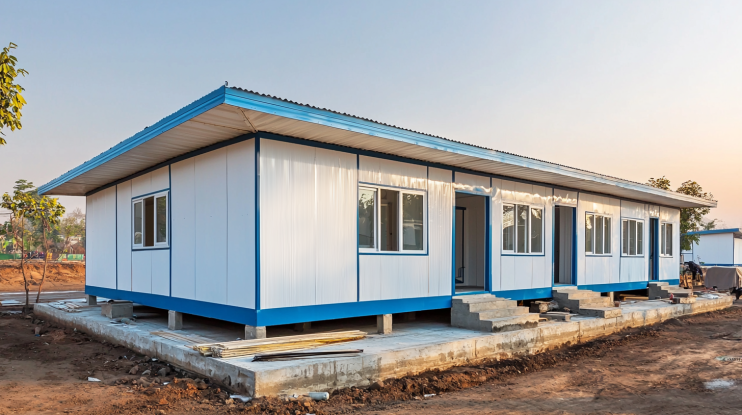
Single-storey prefab labor colony with a blue GI frame and white puff panel walls
The Future of Labor Accommodations in 2024
The future of labor accommodations is shaped by technological advancements, sustainability, and worker-centric design. In 2024, labor accommodations are expected to be more comfortable, efficient, and adaptable. This includes the integration of smart technology, sustainable materials, and modular designs. These features not only improve the quality of life for workers but also reduce operational costs.
Investing in the future of labor accommodations is crucial for companies. As the demand for skilled labor increases, so does the need for high-quality accommodations. Companies that prioritize worker well-being will be better positioned to attract and retain talent. Furthermore, modern labor accommodations contribute to the overall success of projects by improving productivity and reducing turnover.
In conclusion, the future of labor accommodations in 2024 is bright. Companies that invest in modern, sustainable, and worker-centric accommodations will benefit from higher productivity, lower costs, and greater worker satisfaction. This is why it’s important to stay ahead of the trends and invest in the best possible accommodations for your workers. Learn about the latest innovations in prefab labor colonies.
FAQs About Labor Colonies
Q1: What is a labor colony?
A1: A labor colony is a designated living area specifically constructed to house workers, particularly in industries or projects that require a large workforce. These colonies are often found in remote locations or areas where temporary or semi-permanent housing is needed. Labor colonies are designed to provide essential amenities, including housing, sanitation, food services, and sometimes recreational facilities, ensuring that workers have a comfortable and safe environment while on the job.
Q2: What are the key features of a modern labor colony?
A2: Modern labor colonies are equipped with several essential features to ensure the well-being and productivity of workers. These include:
- Sustainable design: Eco-friendly materials and energy-efficient systems reduce environmental impact and operational costs.
- Safety and security: Advanced security measures, such as surveillance systems, secure access points, and fire safety equipment, are standard.
- Comfortable living spaces: Proper ventilation, climate control, and ergonomic furniture ensure a comfortable living environment.
- On-site amenities: Recreational facilities, medical services, and communal areas are provided to enhance the quality of life for workers.
Q3: How do labor colonies benefit employers?
A3: Labor colonies provide numerous benefits to employers, including:
- Enhanced productivity: Comfortable and well-equipped living conditions lead to happier, healthier, and more productive workers.
- Reduced turnover: Quality accommodations help retain skilled workers, reducing the costs associated with recruitment and training.
- Improved safety: On-site facilities reduce the need for workers to travel long distances, lowering the risk of accidents and improving overall safety.
- Compliance: Properly managed labor colonies ensure compliance with health and safety regulations, reducing the risk of legal issues.
Q4: What are the challenges of setting up a labor colony in a remote location?
A4: Setting up a labor colony in a remote location presents several challenges, including:
- Infrastructure: Remote areas often lack basic infrastructure, such as roads, electricity, and water supply, making setup more complex and costly.
- Logistics: Transporting materials and workers to remote sites can be difficult and expensive.
- Self-sufficiency: Remote labor colonies must be self-sufficient, with reliable power sources, water purification systems, and waste management solutions to support daily operations.
- Environmental conditions: Harsh weather and difficult terrain may require specialized construction methods and materials to ensure durability and comfort.
Q5: How does modular construction benefit labor colonies?
A5: Modular construction offers significant benefits for labor colonies, including:
- Speed: Modular buildings are constructed off-site and then assembled on-site, reducing construction time.
- Flexibility: Modules can be added, removed, or reconfigured as project needs change, offering flexibility in design and capacity.
- Cost-effectiveness: Off-site construction reduces labor and material costs, making modular labor colonies a more affordable option.
- Quality control: Building in a controlled environment ensures higher quality and consistency in construction.
 Container Cafe
Container Cafe
















































































